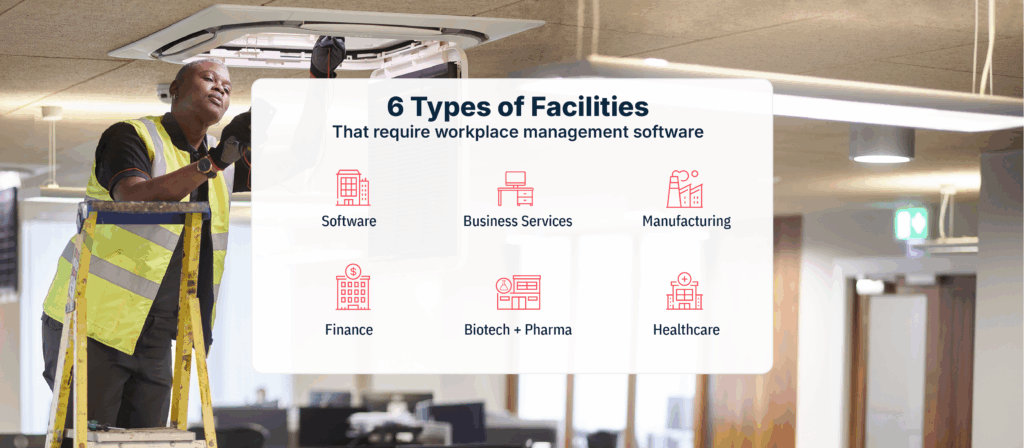The preventive maintenance checklist for facility managers
By Chelsea Ingber• 9 mins read•March 10, 2022

A facility checklist is an essential first step towards better preventative maintenance and keeping the office in good working order. The more facility managers (FMs) are able to monitor and track their buildings, the more future-proofed their workspaces will be.
In this article, we explore the nuances of facility checklists, along with why you need them, and what you should include on yours.
What is a preventive maintenance checklist?
Like the name suggests, a preventive maintenance checklist is an explicit catalog that tracks the state of your entire facility. A good checklist lets you monitor and record:
- The current state of your facility
- What maintenance items you’ve checked and/or completed
- What still needs to be done (and when)
- Upcoming upgrades
- The work of outside contractors
Also called a facility inspection checklist, this is the record-keeping that lets FMs and other managers monitor their entire workspace and keep all systems in good condition.
Roofs get damaged, plumbing can spring leaks, fire extinguishers expire, space gets wasted, employees can lose access to the networks and resources they need to do their best work. Any number of issues directly related to the workspace itself can impact productivity and safety. Even something as simple as dirty windows can affect workplace experience. A facility checklist is the answer to preventing these problems, making it a critical tool for both facility planning and workplace management.
Ultimately, the most important FM responsibilities are to keep facilities humming along smoothly, so that every employee has a safe environment and access to all the tools they need to be most productive. Using a facilities management checklist is a smart first step in this process.

Benefits of a preventive maintenance checklist
When it comes to facility management services, prevention is the name of the game. FMs need to keep everyone safe and productive today, while also arranging to keep them safe and productive in the future.
Preventative maintenance keeps small problems from becoming big problems. We all know this intuitively: better safe than sorry. By building in regular facility checkups to their routine, a good checklist can alert FMs to developing concerns. And it can help them prevent problems before they start.

Learn more about preventative maintenance software from OfficeSpace.
What to include on a facility inspection checklist
All buildings and workspaces require regular maintenance. This is as true for large scale enterprise facility management as it is for a distributed workforce spread out across small workstations.
While every maintenance checklist will look different, most FMs can benefit from a checklist template that includes a customized combination of the following 10 key elements of facilities maintenance. Most facilities can benefit from daily, monthly, and yearly checklists. You should also expect your checklist to evolve over time.
Simplify maintenance requests with Facility Requests. Ensure seamless issue tracking and resolution.
1. Building exterior
Note that depending on your leasing agreement, an FM may or may not be responsible for building and exterior maintenance.
That said, many FMs will be responsible for maintenance inspection—or arranging for professional maintenance inspection—of the following areas, in any or all of their office buildings:
- Roof
- Foundation
- Overall building structure
- Parking lots, garages, and exterior storage areas
- Windows, doors, and gates
2. Grounds
Some facilities management teams are responsible for also maintaining the facility grounds, whether that’s through hiring an outside contractor or assigning this duty to someone on staff.
It’s important to note that some facilities also have additional grounds that need to not only be maintained, but also monitored.
For example, if a building has a rooftop garden or repurposes plumbing water to irrigate their plants, then the FM would be responsible for hiring the right grounds people with their own preventative maintenance measures in place, and for checking in with them on a regular basis.
As companies are now looking for more ways to return to the office while maintaining social distancing, we can also expect to see more physical workstations positioned outside, whether on patios, rooftops, or in gardens.
In this scenario, responsibility for maintenance will likely fall squarely on the shoulders of the FM team—and should therefore also make their way onto the checklist.
3. Building interior
Compared to building exteriors, building interiors are more likely to be under the facility management umbrella.
FMs are usually responsible for a variety of interior details which should also be included on checklists, such as:
- Maintaining amenities and appliances
- Plumbing
- Sprinkler systems
- Receptacles
- Plumbing
- Electrical panels
- Ensuring walkways and work areas are clear of tripping hazards or other obstructions
- Keeping wayfinding signage and systems up-to-date
- Ensuring IoT sensors are working properly
- Ensuring all building spaces are accessible
4. Openings
For both safety and security reasons, the following should always be in working order, and therefore checked daily:
- Windows
- Doors
- Gates—hinges, locks, handles, and seals
- Elevators, where applicable
Critically, this area of predictive maintenance also includes ensuring emergency exits and exit signs are always in good working order.
Remember that being responsible for a maintenance checklist is not necessarily the same thing as being responsible for the maintenance itself.
When it comes to elevators, for example, while the FM isn’t responsible for elevator repair, they likely will be the one responsible for hiring the proper technicians to handle any issues before they become bigger problems.
5. Building automation systems (BAS)
A building automation system (BAS) is an integrated system that, when working properly, keeps a building running smoothly and comfortably. Also called a building management system (BMS), this is an integral and complex component of a physical workspace, and as such needs to be continually monitored.
A BAS usually includes a combination of any or all of the following, all of which need to be tracked carefully:
- Access control
- HVAC—heating, ventilation, and air conditioning
- Lighting systems and lighting control
- Security systems
- Alarm systems
- Emergency systems
- Smoke control
- Energy management monitoring for intelligent buildings
Although BAS are often maintained by an outside mechanical contractor, an FM checklist might include checking in on key systems, as well as overseeing any contractors who may service the building.
FMs should also take extra steps to ensure that security in building automation systems is given top priority by both IT and other management teams.
6. Asset management
Implementing effective asset management is essential to any preventive maintenance strategy. Why? Because every building is made up of assets—desks, HVAC systems, laptops, lighting, security devices, and so much more. If you’re not tracking those assets, it’s nearly impossible to know what needs maintaining, when it was last serviced, or when it’s due for replacement. A good asset management system gives facility managers the visibility and control they need to stay ahead of wear and tear, reduce downtime, and extend the life of critical equipment. It also makes it easier to align maintenance efforts with budget forecasts, supplier schedules, and compliance needs. In short: better asset tracking = smarter, more proactive maintenance.
Learn how OfficeSpace Assets can strengthen your preventive maintenance checklist.
7. Employee resources
Since a primary role of facility maintenance is to create a space where workers can be their most productive, a primary element of any facility maintenance checklist should be ensuring workers have all the resources they need for their day-to-day work.
Specifically, FMs should do regular surveys in the following areas:
- Ensuring equipment is working properly and upgraded as necessary, which includes computers, monitors, desks, chairs, accessories, extension cords, and phones
- Ensuring installations of new equipment go smoothly
- Coordinating to resolve support tickets and issues
- Ensuring employees are able to book clean, available meeting rooms with meeting room booking software
Given the rise in hybrid working, FMs will be responsible for maximizing the hybrid workplace experience as well, which includes providing all employees with good equipment and a safe network connection, regardless of location.
This usually means creating a good digital workspace, preferably one that is cloud-based and easy to integrate with a company’s existing integrated workplace management system (IWMS).
It also means ensuring employees have continued access to the right digital workplace solutions to participate fully in a hybrid meeting.
Finally, FMs should also keep an eye on request management systems to ensure they’re actually serving employees.
Of course, with remote workers, FMs often won’t be able to physically monitor everything on their facility list, at least not in person.
They can therefore implement check-ins with employees, whether that’s through surveys or through an internal request management system.
8. Space planning
Space planning is another area that is complicated by hybrid work. And since space management skills are always at the top of any facilities skills list, FMs should be careful to always keep it top of mind when surveying the office.
Thankfully, if FMs are using good workplace management software, it should be keeping track of data and analytics that can monitor much of this aspect of their checklist for them.
For example, FMs can use this software to get daily reports on critical issues, space utilization, occupancy rates, and building capacity. A tool like portfolio reports dramatically helps in this regard, by offering ready reports about your real estate use.
“It’s incredibly important for me to be able to check the density of each of our offices in real-time—what’s occupied, what isn’t—because I’m not able to be in every location,” says Bernard Morrissey, Chief Officer for Real Estate and Facilities and K&L Gates, when describing the efficacy of these space management reports. “So when I have a question like ‘What’s the situation in Tokyo?’ I can go to OfficeSpace and get the answer in seconds.”
9. Move management
Move management is another critical system that FMs need to audit regularly. If one piece of these systems is missing, suddenly it’s much harder for everyone on the team to keep up with the daily fluctuations of a working office.
Specifically, FMs should ensure there are always up-to-date systems in place for:
- Managing moves
- Making and tracking desk locations, meeting rooms, and equipment
10. Employee health and safety
Just because an FM doesn’t have to wrangle with forklifts or hazardous materials, doesn’t mean they don’t also have important health and safety obligations to their workers. In fact, because of the importance of health and safety, especially in a post-pandemic era, many FMs will maintain a separate safety checklist, which they may even make public.
“People need messaging when you make improvements to health and safety,” says Angie Earlywine, Senior Director in the Total Workplace division of Global Occupier Services at Cushman & Wakefield. “Be open and talk about what improvements you’ve made to the work environment. Oftentimes, cleaning crews come in like Batman in the dark of night after hours. But now, we don’t mind seeing them. We almost want to see those physical reminders that our personal well-being is important.”
In other words, FMs should keep a rigorous health and safety checklist, and they should also make sure that workers are aware of their efforts in this area.
That’s why a tool like Safeguard, which automates wellness checks, can be so powerful. Not only does it help companies stay compliant with ever-changing regulations. It also gives employees a daily reminder that their organization is committed to their health.
11. Facility safety
Meanwhile, many of the issues already covered, like HVAC systems and emergency exits, are also closely connected to facility safety. Moving beyond these issues, a FM safety checklist will likely include elements like providing, inspecting and maintaining:
- Personal protective equipment (PPE)
- Fire equipment and fire alarms
- First-aid kits
These checklists should also keep track of when safety inspections were last completed on these items, and on the workspace overall.
And going forward, FMs can expect to be responsible for ensuring social distancing as well; by carefully tracking how workers are using the space, they will be in a better position to keep them safe, as well as to make recommendations for how to improve workplace strategy. A tool like Distancing Planner further simplifies this process by making it easy to maximize the amount of seating you can safely use in any given setting.
Finally, note that depending on their company’s commitment to employee experience, the facility checklist may extend to areas surrounding employee well being. For example, FMs may want to create and track surveys that assess employees’ stress levels or other markers of mental health.
12. Managing suppliers
Like we’ve covered, FMs may be responsible for creating a system for predictive maintenance. But that doesn’t mean they’re the ones scrubbing the windows or fine tuning the BAS. Instead, they have to help make and manage any and all contracts related to facility management. This often includes overseeing the lease management system as well.
A final element of any facility checklist should therefore also include a space for FMs to check up on everyone else who contributes to facility maintenance, such as:
- Custodians
- Grounds keepers
- Controls/HVAC contractors
Depending on their setup, IT and HR departments may also be involved in sourcing and managing these suppliers, as well as in other elements of facility maintenance. That’s why collaboration in the workplace between these departments is often a good idea, including when it comes to checklists.

From spreadsheets to preventive maintenance software
There’s no doubt that facility checklists are critical to a well functioning office. But they’re also just the first, easiest step. Real predictive maintenance also requires you to take corrective action when necessary.
FMs should therefore look to develop checklists that help them quickly identify small problems, so they can be remedied before becoming bigger ones.
What is a preventive maintenance checklist?
A preventive maintenance checklist is a structured list of tasks and inspections used to routinely assess and maintain equipment, systems, or facilities. Its purpose is to ensure everything stays in good working condition, helping to reduce unexpected failures and costly downtime.
What are the 7 elements of preventive maintenance?
The seven key elements typically include: inspection, detection, correction, prevention, scheduling, documentation, and training. Together, they create a comprehensive strategy that keeps assets reliable and extends their lifespan.
What are the 4 types of preventive maintenance?
The four main types are: time-based (scheduled at regular intervals), usage-based (based on runtime or cycles), predictive (based on condition monitoring), and prescriptive (driven by data and AI recommendations).
What is the 10 rule of preventive maintenance?
The “10 rule” refers to the idea that every dollar spent on preventive maintenance can save up to ten dollars in future repair or replacement costs. It’s a reminder of the cost-effectiveness of staying proactive.
How do I do a maintenance checklist?
Start by identifying all assets and their maintenance needs. Then, create a list of tasks for each one, assign a frequency (daily, weekly, monthly, etc.), and track completion. Using workplace management software can streamline this process with automation and reminders.
What is basic preventive maintenance?
Basic preventive maintenance includes simple, routine actions like cleaning, lubricating, tightening, inspecting, and replacing worn parts. These tasks help keep equipment running smoothly and prevent small issues from becoming major problems.
OfficeSpace offers a workplace solution that streamlines facility checklists and preventative maintenance. Get a free demo today!
Photos: Dose Media, Tiger Lily, Alex Green, Thirdman



